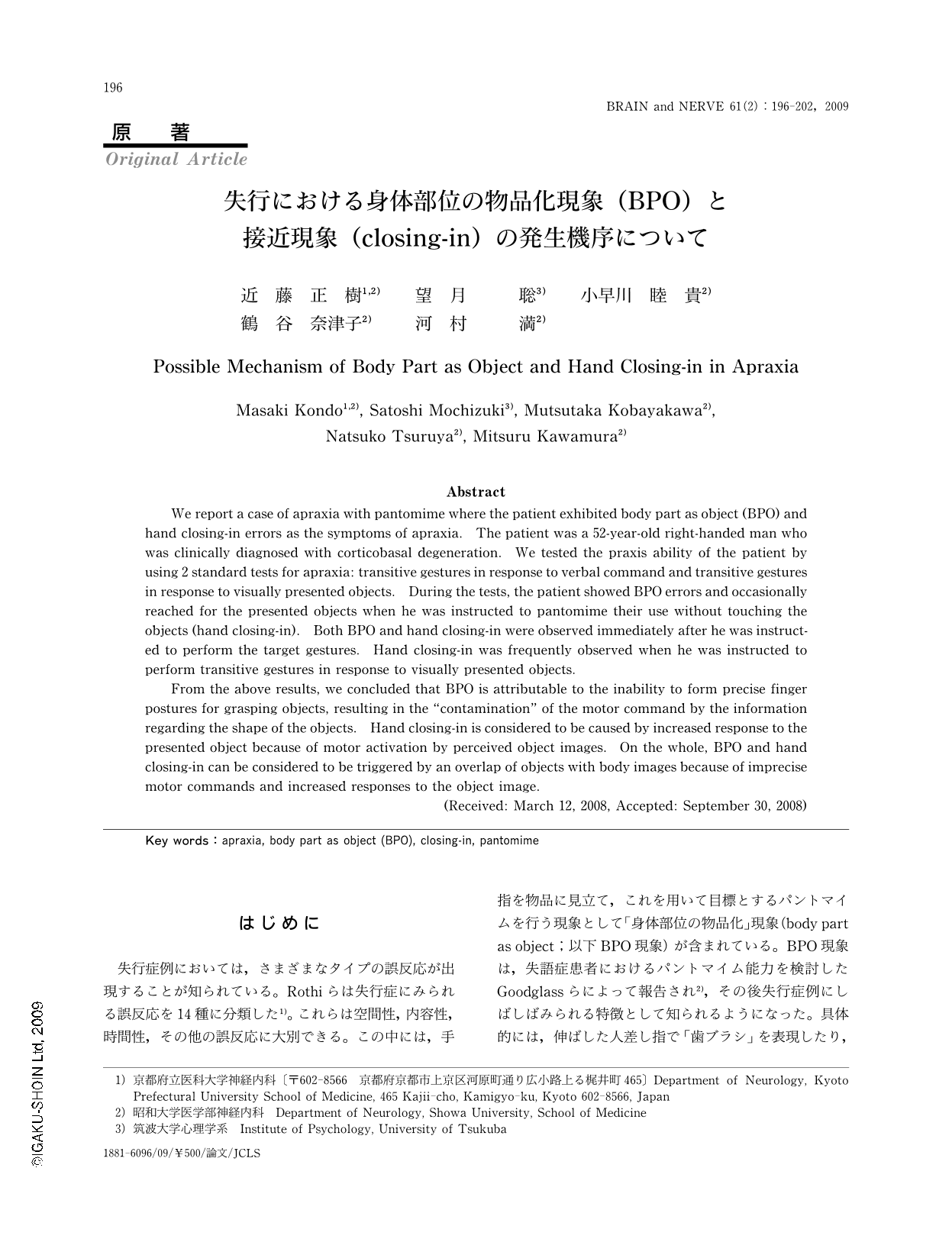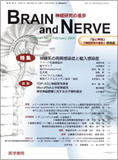Japanese
English
- 有料閲覧
- Abstract 文献概要
- 1ページ目 Look Inside
- 参考文献 Reference
はじめに
失行症例においては,さまざまなタイプの誤反応が出現することが知られている。Rothiらは失行症にみられる誤反応を14種に分類した1)。これらは空間性,内容性,時間性,その他の誤反応に大別できる。この中には,手指を物品に見立て,これを用いて目標とするパントマイムを行う現象として「身体部位の物品化」現象(body part as object;以下BPO現象)が含まれている。BPO現象は,失語症患者におけるパントマイム能力を検討したGoodglassらによって報告され2),その後失行症例にしばしばみられる特徴として知られるようになった。具体的には,伸ばした人差し指で「歯ブラシ」を表現したり,握った拳によって「ハンマー」を表現したりする動作が挙げられる。この現象は健常成人においても時にみられるが,健常成人では「その物品を実際に持って使用しているつもりになってパントマイムをする」ように命ずれば,正しく行うことが可能となる。失行の誤反応としてのBPO現象は,教示をしてもなお出現する場合を指す3)。この現象そのものはよく知られているが,発現機序に関してはHaalandらの研究4)以外にはほとんど考察がなく,不明な点が多い。
われわれはパントマイム失行を呈した大脳皮質基底核変性症(corticobasal degeneration: CBD)疑い例において,失行検査中にBPO現象を認めたほかに,視覚呈示された物品について,それには触れずにパントマイムを行うよう求めると,呈示された物品に右上肢が近づいてしまう「上肢接近現象」を観察した。
本研究ではBPO現象と上肢接近現象についての検討結果を述べ,これらの生ずるメカニズムについて考察する。
Abstract
We report a case of apraxia with pantomime where the patient exhibited body part as object (BPO) and hand closing-in errors as the symptoms of apraxia. The patient was a 52-year-old right-handed man who was clinically diagnosed with corticobasal degeneration. We tested the praxis ability of the patient by using 2 standard tests for apraxia: transitive gestures in response to verbal command and transitive gestures in response to visually presented objects. During the tests, the patient showed BPO errors and occasionally reached for the presented objects when he was instructed to pantomime their use without touching the objects (hand closing-in). Both BPO and hand closing-in were observed immediately after he was instructed to perform the target gestures. Hand closing-in was frequently observed when he was instructed to perform transitive gestures in response to visually presented objects.
From the above results, we concluded that BPO is attributable to the inability to form precise finger postures for grasping objects, resulting in the "contamination" of the motor command by the information regarding the shape of the objects. Hand closing-in is considered to be caused by increased response to the presented object because of motor activation by perceived object images. On the whole, BPO and hand closing-in can be considered to be triggered by an overlap of objects with body images because of imprecise motor commands and increased responses to the object image.
(Received: March 12,2008,Accepted: September 30,2008)

Copyright © 2009, Igaku-Shoin Ltd. All rights reserved.


